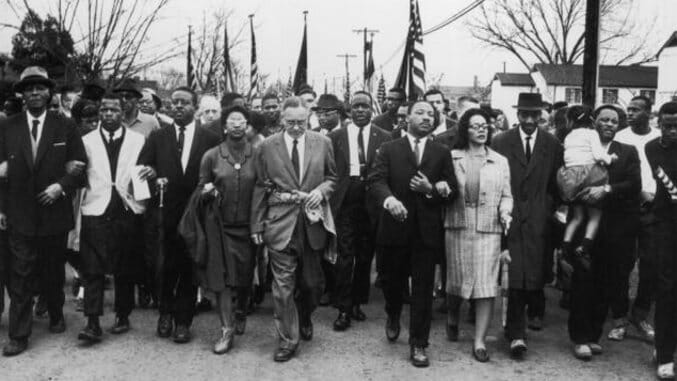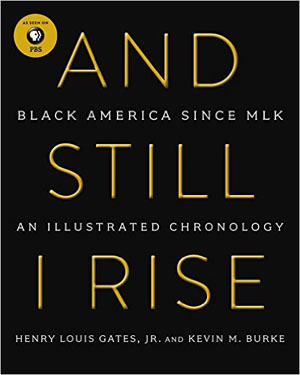And Still I Rise: Black America Since MLK by Henry Louis Gates, Jr. and Kevin M. Burke
Photo by William Lovelace / Stringer Books Reviews America
As parents, students and teachers struggle with the current state of the American educational system, there have been a handful of small but significant gestures made over the years in an attempt to correct one of the biggest issues in the history lessons young people receive. A mother recently took to social media to share a page from her child’s newly-published McGraw-Hill Education textbook, wherein the Atlantic Slave Trade was labeled as a “pattern of immigration” and the brutality of slavery described in one caption as an event where “millions of workers” were brought from Africa to “work on agricultural plantations.” The story went viral, and the publishing company is now investigating their “mistake.”
 Last year, free screenings of Ava DuVernay’s film Selma were offered for elementary students across the country. And in 2014, Steve McQueen’s Best Picture winner 12 Years a Slave inspired The National School Boards Association to add the film, along with the original autobiography and a study guide, to high school curriculums. And Still I Rise: Black America Since MLK is one more incredible work that deserves a space, not only in home book collections and university libraries, but in our elementary and high school classrooms, many of which are still starved for a visually compelling and well-rounded dive into Black America as it continues to rise, fall and rise again over the years.
Last year, free screenings of Ava DuVernay’s film Selma were offered for elementary students across the country. And in 2014, Steve McQueen’s Best Picture winner 12 Years a Slave inspired The National School Boards Association to add the film, along with the original autobiography and a study guide, to high school curriculums. And Still I Rise: Black America Since MLK is one more incredible work that deserves a space, not only in home book collections and university libraries, but in our elementary and high school classrooms, many of which are still starved for a visually compelling and well-rounded dive into Black America as it continues to rise, fall and rise again over the years.
The illustrated chronology and companion book to the PBS series of the same name poses a plethora of questions in its introduction, beginning with, “What binds African Americans together?” and ending with, “Given the sheer diversity and divergence…within Black America…is it still even possible to think of forty-two million people as a unified cultural social entity at all?” Henry Louis Gates, Jr. has been attempting and providing various answers to such questions since his seminal work in literary criticism (The Signifying Monkey) and with incredible anthologies (Reading Black, Reading Feminist and Tradition and the Black Atlantic). In every literary exploration, he’s offered up a lesson in intersectional thinking—a lesson sorely missing from much of American curriculum (all the way from elementary school to higher education).
It’s not a critique to say that And Still I Rise is one of the more accessible works of his catalogue. Along with Kevin M. Burke, Director of Research at Harvard University’s Hutchinson Center for African and African American Research, Gates uses hundreds of images—ranging from powerful shots like Malcolm X holding up a newspaper headline reading “Our Freedom Can’t Wait!” to images of the countless race-related protests and riots that have swept this country, including Stanley Forman’s Pulitzer Prize-winning The Soiling of Old Glory (which captures a white teen attacking a black lawyer and activist with the American flag on a pole during the busing crisis—a history lesson which never made it into my elementary education in Boston). But many more photos tell other stories of black history and culture—the movie poster featuring Pam Grier from Foxy Brown, NASA astronaut Ronald E. McNair playing his saxophone on the Challenger space shuttle and Arsenio Hall removing his sunglasses to deliver a late-night monologue are all given equal weight and attention in this collection.
Similar to what Steve Stoute did with his docu-series The Tanning of America, Gates and Burke place pop culture and the growing popularity of black music, and especially hip-hop, at the center of a historical narrative (in this way, there’s a continuation of the work Gates has done with the Hiphop Archive & Research Institute and the W. E. B. Du Bois Research Institute at Harvard). There is, in the text, a direct correlation made between the success and visibility of black artists, entertainers and athletes and the socio-political climate for African Americans. Stoute described his work as drawing “a line from Sedgwick Avenue to Pennsylvania Avenue.” While And Still I Rise inspires a similar conversation, it’s on a much grander, all-encompassing scale.
For example, in 1983 we learn that Harold Washington, Jr., becomes Chicago’s first black mayor, Jamaica Kincaid releases her first book At the Bottom of the River and Michael Jackson debuts the moonwalk. In 1993, Maya Angelou reads “On the Pulse of the Morning” at President Bill Clinton’s inauguration, Dr. Joyce Elders becomes the first black Surgeon General (and argues strongly for universal health care and sex education in schools), Living Single premieres and the Wu-Tang Clan releases Enter the Wu-Tang (36 Chambers). All of these events must be read alongside each other, their own unique pearls strung on this great thread, putting the current state of America and Black America in perspective.
What’s thrilling and terrifying about the narrative is that it opens and closes with two Selmas—the 1965 location of King’s first direct-action campaign after receiving the Nobel Peace Prize, and Ava DuVernay’s 2014 Oscar-nominated film. From “We Shall Overcome,” to “Black Lives Matter,” Gates and Burke insist on an American history and present that is complex, nuanced and tragically repetitive. But the text, like the poem that inspires the title, is ultimately hopeful. As much as history overwhelms the book, the final chapters are highlighted with tributes to Shonda Rhimes and history-making shows like Scandal, Empire and Key & Peele, Kendrick Lamar, Jay Z, Beyoncé and other familiar faces who represent a shift—what that shift signifies, exactly, is not something this collection is willing (or has the ability) to name. But there is an acknowledgement that “we’ve come this far” by faith and work and, still, there are “many rivers to cross.”
Like any text, And Still I Rise can only do so much. In many ways, it’s simply a timeline, a series of snapshots—and even with a deft collection of narrative endnotes, this is not the final, fully comprehensive work on black experiences in America since the ‘60s. But it’s a powerfully good start, and anyone looking for ideas for the next great novel, film, comic book or biopic could easily start on any page of Gates and Burke’s work. It moves beyond mere textbook status and into the start of what will hopefully be an ongoing, creative and intensely intersectional conversation about black lives and minds—and how they have shaped America in every way.
Shannon M. Houston is Assistant TV Editor & a film critic at Paste, and a writer for Salon and Heart&Soul. This New York-based freelancer probably has more babies than you, but that’s okay; you can still be friends. She welcomes almost all follows on Twitter.